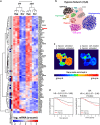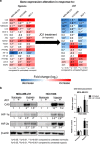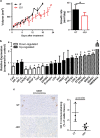The BET inhibitor JQ1 selectively impairs tumour response to hypoxia and downregulates CA9 and angiogenesis in triple negative breast cancer
- PMID: 27292261
- PMCID: PMC5061082
- DOI: 10.1038/onc.2016.184
The BET inhibitor JQ1 selectively impairs tumour response to hypoxia and downregulates CA9 and angiogenesis in triple negative breast cancer
Abstract
The availability of bromodomain and extra-terminal inhibitors (BETi) has enabled translational epigenetic studies in cancer. BET proteins regulate transcription by selectively recognizing acetylated lysine residues on chromatin. BETi compete with this process leading to both downregulation and upregulation of gene expression. Hypoxia enables progression of triple negative breast cancer (TNBC), the most aggressive form of breast cancer, partly by driving metabolic adaptation, angiogenesis and metastasis through upregulation of hypoxia-regulated genes (for example, carbonic anhydrase 9 (CA9) and vascular endothelial growth factor A (VEGF-A). Responses to hypoxia can be mediated epigenetically, thus we investigated whether BETi JQ1 could impair the TNBC response induced by hypoxia and exert anti-tumour effects. JQ1 significantly modulated 44% of hypoxia-induced genes, of which two-thirds were downregulated including CA9 and VEGF-A. JQ1 prevented HIF binding to the hypoxia response element in CA9 promoter, but did not alter HIF expression or activity, suggesting some HIF targets are BET-dependent. JQ1 reduced TNBC growth in vitro and in vivo and inhibited xenograft vascularization. These findings identify that BETi dually targets angiogenesis and the hypoxic response, an effective combination at reducing tumour growth in preclinical studies.
Figures






Similar articles
-
Identification of a stemness-related gene panel associated with BET inhibition in triple negative breast cancer.Cell Oncol (Dordr). 2020 Jun;43(3):431-444. doi: 10.1007/s13402-020-00497-6. Epub 2020 Mar 12. Cell Oncol (Dordr). 2020. PMID: 32166583 Free PMC article.
-
Vitamin C supplementation expands the therapeutic window of BETi for triple negative breast cancer.EBioMedicine. 2019 May;43:201-210. doi: 10.1016/j.ebiom.2019.04.006. Epub 2019 Apr 8. EBioMedicine. 2019. PMID: 30975544 Free PMC article.
-
Anti-tumor activity of BET inhibitors in androgen-receptor-expressing triple-negative breast cancer.Sci Rep. 2019 Sep 16;9(1):13305. doi: 10.1038/s41598-019-49366-9. Sci Rep. 2019. PMID: 31527644 Free PMC article.
-
Modulation of carbonic anhydrase 9 (CA9) in human brain cancer.Curr Pharm Des. 2010;16(29):3288-99. doi: 10.2174/138161210793429788. Curr Pharm Des. 2010. PMID: 20819065 Review.
-
Targeting hypoxia-inducible factor-1alpha: A new strategy for triple-negative breast cancer therapy.Biomed Pharmacother. 2022 Dec;156:113861. doi: 10.1016/j.biopha.2022.113861. Epub 2022 Oct 10. Biomed Pharmacother. 2022. PMID: 36228375 Review.
Cited by
-
The emerging role of BET inhibitors in breast cancer.Breast. 2020 Oct;53:152-163. doi: 10.1016/j.breast.2020.08.005. Epub 2020 Aug 13. Breast. 2020. PMID: 32827765 Free PMC article. Review.
-
BET Epigenetic Reader Proteins in Cardiovascular Transcriptional Programs.Circ Res. 2020 Apr 24;126(9):1190-1208. doi: 10.1161/CIRCRESAHA.120.315929. Epub 2020 Apr 23. Circ Res. 2020. PMID: 32324495 Free PMC article. Review.
-
Metabolic Flexibility Is a Determinant of Breast Cancer Heterogeneity and Progression.Cancers (Basel). 2021 Sep 19;13(18):4699. doi: 10.3390/cancers13184699. Cancers (Basel). 2021. PMID: 34572926 Free PMC article. Review.
-
Replication Study: BET bromodomain inhibition as a therapeutic strategy to target c-Myc.Elife. 2017 Jan 19;6:e21253. doi: 10.7554/eLife.21253. Elife. 2017. PMID: 28100400 Free PMC article.
-
Modeling combination therapy for breast cancer with BET and immune checkpoint inhibitors.Proc Natl Acad Sci U S A. 2018 May 22;115(21):5534-5539. doi: 10.1073/pnas.1721559115. Epub 2018 May 7. Proc Natl Acad Sci U S A. 2018. PMID: 29735668 Free PMC article.
References
Publication types
MeSH terms
Substances
Grants and funding
LinkOut - more resources
Full Text Sources
Other Literature Sources

